Howells of Tate County Mississippi

My Howell line has been notoriously difficult to trace. It seems that I'm the only one to
have followed it very far into the past. But thanks to genealogical work and DNA, I've
been able to piece it together, at least to around the immigration point. Howell is a
Welsh surname, which provides guidance on the ultimate origin. The flag above is for
Wales, part of the United Kingdom. If you've read the stories of my Scott and McAtee
lines, you'll notice that they came from Scotland and Ireland. It so happens that the
last of my great-grandfather level lines is Hollis, which is English. So, my family tree
covers all corners of the British Isles, just in my grandparents.
Boomer Sooner
The first phase of this journey will be told with respect to the individual men of our Howell
line, going back as far as I have names for them. Though we probably never will know the
names of earlier men, there is still quite a story to tell of earlier times. The second
phase will take our line back to Wales, and how the line's Y-chromosome tells us where they
came from before the advent of human civilization. The final phase will cover the rest of
the family tree of Sam Howell, my great-great grandfather, through all of his great-great
grandparents. Keep in mind that most of them lived their lives before the Revolution.
The troubles with determining our Howell line begin immediately with my great-grandfather
Dave. One thing an American genealogist learns right away is that a family tree should be
completely provable going back to 1850. That is, if there were no unknown adoptions or
secret grandmother-dalliances. I only had one brick wall remaining in my tree after
1850, which of course regards our Howells, and I'll get to that shortly. But the reason
why a family tree can be documented back to 1850 is the US census. Starting in 1850, it
listed all people in a household by name and age and relation. That allows for proof of
parentage from generation to generation. From 1790 to 1840 the US conducted a census, but
the only person named in it was the head of household. Other members are listed, but only
by gender and age. Therefore prior to 1850, it gets difficult to identify wives and
children. Even after 1850, people fell through the cracks and changed their mind on when
and where they were born. And the 1890 census was lost almost entirety.
Dave Howell was born in 1895, so he should've been connectable to his parents in the 1900
and 1910 censuses. But I haven't found him in any record
during that time. I might've never known who his parents were (save for DNA), if not for
the saving grace of his death certificate. That identified his father as Sam D, which
allows for tracing my Howell line back. Dave always claimed to have been born in Oklahoma.
Oklahoma didn't become a state until 1907, and in 1895 was split into the Oklahoma and Indian
territories. The Indian territory was the eastern part, and the Oklahoma territory
the western. Since form searches haven't found Dave, and no hint is suggested by
ancestry.com, I've manually searched the entire 1900 census looking for Dave and Sam and
Dave's mom Beulah. I found one similar family in Ardmore with an Eddy born 1896 whose
father's mother was born in Alabama and his mother's mother was born in Mississippi. The names
of the parents are unreadable, and the names of the siblings aren't found in our Howell
line. This is unlikely to be Dave, but this was the second-closest match I could find.
Not being able to read names like this case is very common in both the Oklahoma and Indian
territory censuses of 1900. Whole swaths of both could easily hide Dave's family. I don't
know why the scans are such bad quality. The documents are held in Salt Lake City, and a
local LDS library might be of assistance in the matter.
The closest match that I found was in township 1 of the Chickasaw nation, where was a Dave
C who was born 1895 in the Indian territory. The head's father was born in Alabama and
mother in Mississippi. The head was born in 1854, where Sam was born in 1860. The
transcription claims the surname is Phillips and the head's name is Bruce, but I can't read
it at all and have no idea how a machine could tell. It's most likely this isn't our Dave,
either way. My guess is Dave and family were in either territory somewhere in 1900, and
their enumeration is obscured. The greater mystery is what happened to Sam. Dave and his
mother moved back to northwest Mississippi by the 1910s, but I haven't found Sam after 1880.
I haven't found siblings of Dave. Dave's relative Jasper Morris was wed in Carter County
Oklahoma and was in Wetumka, Hughes County in the 1910 census. These could be leads.
All this said, there's another thing to consider regarding Oklahoma at this time in
understanding the Howell move there, something big that happened right
before Dave was born, which we will get to presently.
My mother was born in Oklahoma. Her mother was born in Oklahoma. Oklahoma therefore has
always been associated in my mind with that part of my family. I had no idea that any
other part of my ancestry had anything to do with Oklahoma. Dave Howell was my dad's
grandfather, and my dad didn't know that Dave was born in Oklahoma. All my dad knows
about Dave is he painted houses in the Memphis area. I used to consider Dave's claim of
being born in Oklahoma to have been a strange two-decade vacation my Howell line took,
falling off the grid for a while as it were. This is not only because I've found no
documents in that period, but because Dave's dad was born in northwest Mississippi, and
Dave's children were born in northwest Mississippi. If he truly was born in Oklahoma, he
came back to where the family had lived before he was born.
I didn't know much about the history of Oklahoma either. I know the football team is
called Sooners because of how people settled there, but I've learned now that I didn't
know the details. I guess it never came up because it's not taught in Arkansas public
school (I grew up in Fort Smith, which is right on the border with Oklahoma), and my
mother's grandfather brought that part of my family to Oklahoma after World War I. They
weren't Sooners or Boomers or whatever. But I only had to scratch the surface of the
circumstances of Dave Howell's birth and the history of Oklahoma to realize there was a
connection in that part of my family.
In case you could use a brushing up on Oklahoma history, I'll tell a bit of it now. It
became a state in 1907. But Americans lived there probably even before the Louisiana
Purchase of 1803, which formally added Oklahoma to the United States. After the Purchase,
settlers began to cross the Mississippi River in earnest. The first destination was
Louisiana itself, where Americans had been engaged in trade for decades already. The
second was Missouri, organized into a state after Illinois. Development flowed from
there to Arkansas and the coming Revolution in Texas. Oklahoma counties didn't become
official until 1907, but they'd been developing at the same time as counties in Texas to
the south and Kansas to the north, at least for two decades.
But the key part of Oklahoma history that impacts my Howell line, and is the source of
the terms Boomer and Sooner and most of the biggest cities in the state, is the Land
Runs from 1889 to 1893. While the majority of both the Oklahoma Territory and the
Indian Territory were being set aside for Tribal Nations, a portion in the center of
the future state was unassigned. See the map below for the situation in 1875. Those
Unassigned Lands were the basis of the Land Rush, where lots were laid out and could
be claimed on a first-come first-serve basis. This first occurred in 1889, where
settlers gathered in their wagons and on their horses to all sides of
the Unassigned Lands. The Sooners were some rascals, or enterprising individuals,
depending on whether you were one of them, who sneaked into the land to be given away
before the official release and hid near the plots they thought most desirable. Then
they pretended to have ridden faster than anyone else and got all hot and sweaty in
the process. The Boomers were those who were previously raising a ruckus in the halls of
Congress for the Unassigned Lands to be released for white settlement. They were
typically from Kansas and the Midwest. The term ended up also being applied to
land claimers who weren't Sooners.
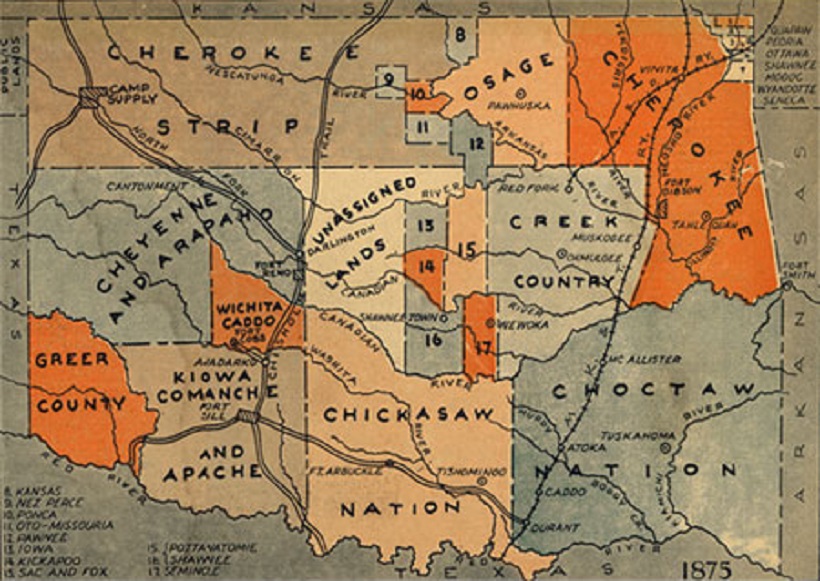
Now look at a modern map of Oklahoma below, and notice that Oklahoma City is right in
the middle of what had been the Unassigned Lands. Norman is in the southern part, and
Stillwater is in the northeastern corner. None of these places existed before 1889,
and after the Land Rush they suddenly appeared. Guthrie is to the north of Oklahoma
City, and in the wake of the Land Rush it competed to be the capitol of the new
country. Obviously it failed to.
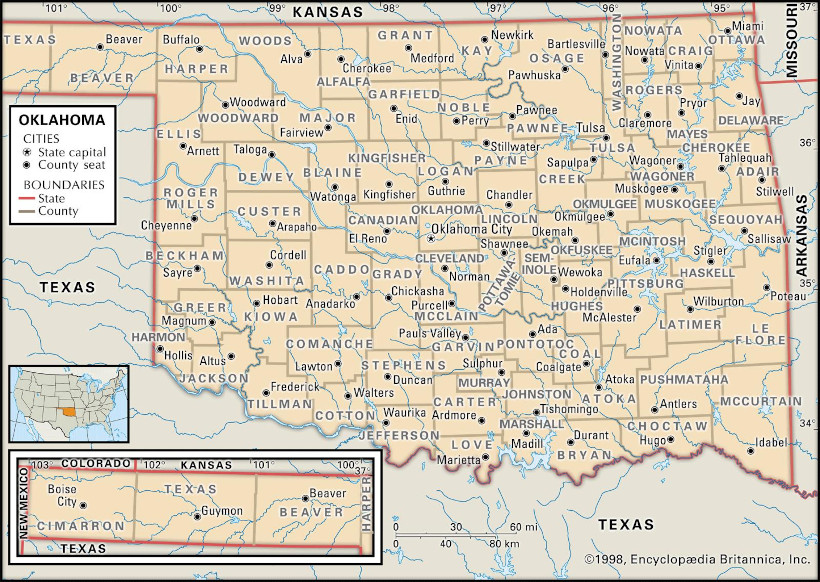
So, Dave Howell was born 1895 in Oklahoma, which strongly suggests
that his parents Sam and Beulah participated in the Land Rush. The fact that Dave
ended up returning to northwest Mississippi and his mother died in Memphis indicates
that their time in Oklahoma didn't go well. Probably Sam wasn't a Sooner and didn't get a choice lot.
But he didn't return at all to Mississippi that I know of. Given that Sam and Beulah
came from pretty much the direct east of the Unassigned Lands, I expect that they
must've travelled through Fort Smith to Purcell on the Canadian River. Purcell is one
of the known places where settlers gathered to rush to find a plot of land. Norman
was founded just to the north of it, and Oklahoma City to the north of that. I expect
that Sam and Beulah must've settled on a plot in that stretch. Any other entry point
would've been out of the way and less likely. I hope to find documentation someday
that will reveal more details, but it seems that Sam must've died in Oklahoma
prematurely. He was 35 years old when Dave was born, and would've been 50 in 1910.
Dave and Beulah turn up back in northwest Mississippi and Memphis after 1920. It
would seem that the Oklahoma experience wasn't a pleasant one for the family, which is
why tales of it weren't passed down. If Dave truly didn't have siblings, it does
suggest that his father died young.
Black Dutch
Dave Howell died in the Memphis area in 1954. As I've stated, my Howells settled in
the Memphis suburbs and general northwest Mississippi area at the eastern edge of the
fertile lands called the Delta. My dad was born in an ambulance in Memphis. The first
record I have of Dave Howell is his enlistment for World War I. One thing from that
document that's remarkable to me is he was apparently illiterate, signing with an 'x'
for "his mark". That's surprising for the 20th century. Maybe it's because of a lack
of schools being available in Oklahoma before 1907? Did it have something to do with
depravation when his father died? I'm not sure. But I'll return to that subject.
Samuel David Howell, Dave's father, was born in Panola County Mississippi in 1860.
While I haven't found documentation of Dave before 1920, I've not found anything for
Sam after 1880. All I had to go on initially for Sam's dad was the 1880 Tate County
census, where his parents were cryptically listed as KD and JA. I managed, by
manually searching area censuses in 1870 to find Sam in DeSoto County. He was listed
as Saml, with father David and no mother. Tate was formed in 1873 out of DeSoto.
Finding Sam in 1860 was even harder. But he was in Panola County Mississippi, named Samuel.
His parents were King D and Nancy. The cursive Nancy in the document is transcribed as Marcey by
ancestry.com, putting another bump in the road to figuring out my Howells. But that
was our Sam.
Amongst the difficulties in stitching these Howell records together, is Sam's mother.
What happened was she died just before the 1870 census, and the JA of the 1880 census
was Sam's stepmother. His mother Nancy died from measles at the age of 34. We
have a picture of her tombstone:
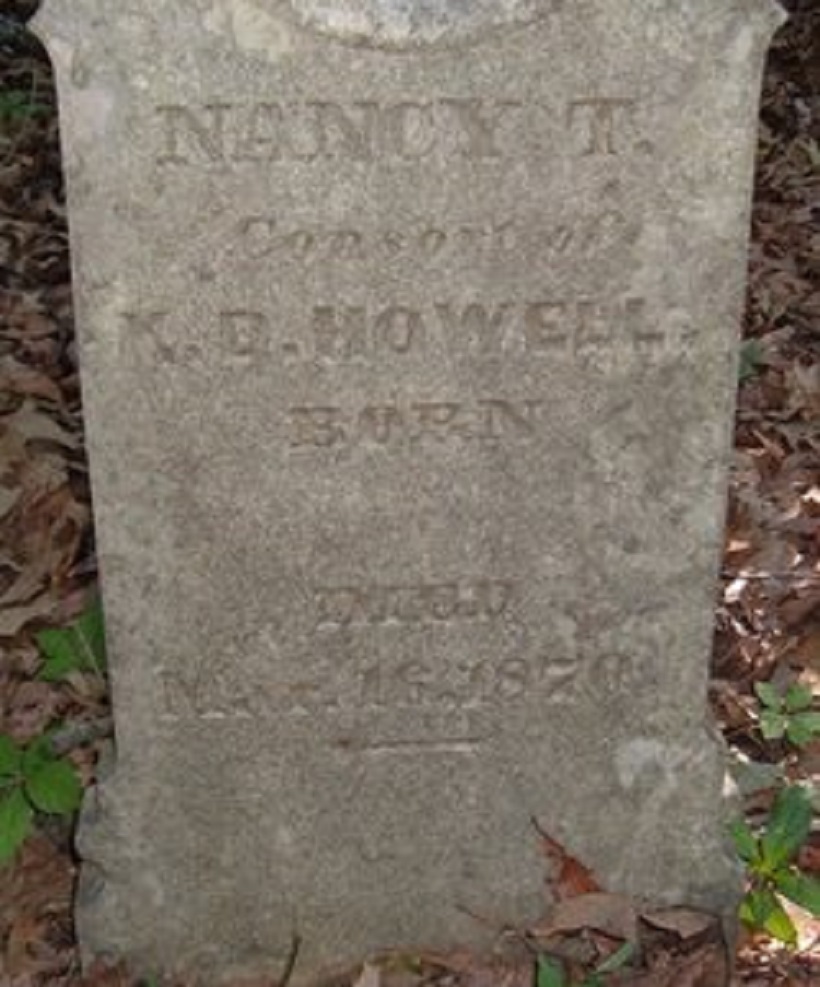
The first thing to remark here is clear proof this is KD Howell's wife. She's named
as his "consort". Consort means the romantic companion of a monarch, an obvious nod
to KD standing for King David. It seems a bad joke to me, her having died so young.
And as fits with our Howells, she's given no maiden name or even a birth year. Others had
done a little work in trying to figure out who she was, and settled on Nancy Wright.
But that's incorrect. There are three reasons I know of for researchers to have come to that (inaccurate)
conclusion: two Nancy Wrights of the correct age lived in the area in 1850 before our
Nancy got married. She listed her birth state as Alabama, and both those girls were
born there. Thirdly, a Nancy Wright died the same year as our Nancy. But she died in
a different county and was the wife of a man named Wright, so that wasn't her maiden
name. And the other two Nancys wed known men who weren't Howells.
This brings me to the title I gave to this section, Black Dutch. In my Scott and
McAtee documents I discussed the term. It was adopted in early America as an invented
ethnicity for people who were a mix of European and Native or African heritage, who
could pass for white but didn't look like typical Europeans. I've been doubtful about
my dad's claim that the Scott side is part Black Dutch, but I believe now that it's
applicable and particularly to the mysterious Nancy T. Why is so little known about
her? Why was she disrespected on her tombstone, when she tragically died young?
A first clue arose in the past couple of years, that I only recently realized was
significant. Me, my dad, my mom, and my mom's mom did autosomal DNA tests about five
years ago with ancestry.com. They produce what's called an ethnicity estimate. As
they refine their methods, this estimate has changed a few times. Some of the changes
have been significant, for example mine coming back as 9% Iberian at first, and now
none at all. It does seem that each update is more accurate, because I had no proof
at all of any Spanish ancestor (not in modern history, anyway). In recent
updates, my dad's estimate began to include 1% Nigerian. It hasn't changed. And now
the last update for me includes 1% Nigerian. Until recently I hadn't taken the time
to make sense of it.
But it must be legitimate. So, I began to take a look at my Scott tree in that
context. Where could Nigerian enter it? Obviously, this means I have one or more
ancestors who were slaves. I won't bore you with the details, but I looked at cousins
related through my dad's side, to see who had Nigerian in their DNA. There can be
false positives, as cousins could have a Nigerian ancestor through another path, but
it is useful as a process of elimination. And I was able to narrow down the potential
source for me in this way to not just the Howell tree, but to Sam Howell's mother.
I've subsequently filled out my entire family tree to my 6th-great grandparents, all
confirmed by DNA, and there's no other path to Nigerian than via Nancy T.
If one of Nancy's ancestors was 100% Nigerian, this would fall at about the
grandparent level for her for it to register a median 1.5% for my dad and 0.75% for me.
That's if every person in between got exactly half of their DNA from each parent. So,
this could vary a generation or two. And it's likely that her recent ancestors were
more than half European.
So, given this situation, have I been able to learn anything about Nancy?
She was a brick wall in my tree for a long time, understandably, given that I didn't
know her maiden name. I know of no marriage document between her and KD. But I didn't
give up. This is a good test case of what can be done with 1850-and-after censuses,
and then how a document lead can combine with DNA to yield results. I only had the
1860 census to go by for her, and the 1870 for all her children. Note that race wasn't
categorized for the family in 1860, but all were classed as white in 1870. I expect
that Nancy herself would've been categorized as mulatto.
Nancy named her first two children Ellen and Martha. Going by that, I manually
searched the 1850 Panola census for a Nancy of the correct age and birthplace who had
relatives named Ellen and Martha. And lo and behold, Nancy T Ellis had a mother named
Ellen and younger sister Martha. These coincidences jump off the page. The only
problem was this Nancy Ellis was born in Tennessee, when ours said she was born in
Alabama. But the family obviously had passed
through Tennessee and Alabama on their way to Panola, because Martha was born in
Alabama. It's very common that people back then were inaccurate in listing their
birthplaces because of migrations, especially in Nancy's case where several states were
involved when she was a child.
Nancy's parents in that census were James and Ellen. Someone who made a family tree
of Panola residents from 1850 claimed Ellen's maiden name was Anderson. I've proven
this to be correct - see below in the non-Howell part of Sam's tree.
In terms of documentation, James Ellis hasn't led anywhere. No hints are returned for
him in other censuses. No parents are suggested for him. If I don't put parents for
him, ThruLines doesn't help to make suggestions. It claims that he's an ancestor, but
with no cousins to connect to him through, so that assertion seems only based on my
claim that he's an ancestor. So, the only way to find cousins to add credence to him
truly being an ancestor is to locate a potential father and enter him in the tree.
Either ThruLines then finds cousins or it doesn't. Race wasn't indicated in the 1850
census to classify James or Ellen as black or mulatto. James was born around 1810,
claimed in North Carolina. Ellen was born around the same time in Tennessee. That
usually means that James traveled from North Carolina to Tennessee and wed Ellen in or
near her home town.
By manually searching the entire 1850 Panola census again, I found an AJ Ellis living
there, who was born 1821 in Tennessee. By searching for him, I found an ancestry.com
member who had his father as John E Ellis from Hawkins County Tennessee. I then took a
shot at assuming that John Ellis was James's father as well. When I did that, ThruLines
identified a Guy Ellis as son of John and half-brother of James, connecting to my dad
thru a contemporary cousin. This is only a single piece of evidence to prove that James
is an ancestor, but it was a bit of a eureka moment.
My father absolutely has a genetic relation to a descendant of Guy Ellis, through John
Ellis. But why half-brother? And while ThruLines claims this connection, I found John
Ellis's will, and he doesn't mention having a son named James. DNA shows that John
Ellis was the father of both Guy and James. But while Guy was the legitimate son of
John's wife, James was the son of a part-Nigerian woman who was John's slave. John
Ellis had slaves in the census, and he mentioned some in his will. See the Ellis section
below for more, including the identity of James's mother.
King David Howell 1837-1890s
Getting back to the Howells, I ran into more trouble figuring out where KD came
from, even though the 1850 census should connect him to his father. Yet, I haven't
found KD in a document before 1860, when he was head of his own household. He wasn't
in DeSoto or Panola counties in 1850. But other Howells were, which led to the
solution. Those Howells were Elijah C, Elizabeth, and Mary Mildred in DeSoto, born
respectively in 1823, 1825, and 1830. KD was born in 1837. He could've been their
younger brother. He moved to live around them by 1860. This in itself isn't proof,
of course. But further researching those three other Howells, Elizabeth wed a man
named Whitsell and Mary became a Wilson. KD had Whitsell children enumerated in his
household in 1860. This sealed the deal, aside from ThruLines confirming it. The
other three's father was Samuel David Howell, which KD named his own son in our
line. Also, KD was born in Georgia as were the other three.
Before tracing the line further back, I want to address the situation they came into
in northwest Mississippi. I've found no evidence that our Howells ever owned slaves.
They evidently were very poor. But it makes me wonder why they moved into the
epicenter of slave-harvested cotton, the Mississippi Delta. The land had become
available in the previous two decades after the Choctaw and Chickasaw were driven
out. It was fertile and good for subsistence farming as well, I suppose. And our
Howells couldn't have predicted the slaves would be freed and they'd find themselves
in impoverished competition with a majority black population. The failings of
reconstruction may have played the most fundamental role in illiteracy in this line
persisting into the 20th century. One potential benefit of living at the crossroads
of the Delta and Memphis though, was exposure to great music, and I've heard tales
of our Howells being into Country and Elvis. Of the latter I've heard of a relative
stringing his guitar, or something of the sort. Elvis was from nearby Tupelo. KD
was the Howell who brought our line to northwest Mississippi, beginning a span there
of about a century. He was a confederate soldier in the Mississippi Second Cavalry.
Howells in Virginia
KD's father Samuel David (I'll call him SD) wed Sally Brown in Elbert County Georgia
in 1821. A Samuel Howell was in the Elbert census in 1820 and 1830. The latter
fits with our SD, with Elijah born in 1823 through KD born in 1837. Since pre-1850
censuses don't list anyone by name but the head, it's not clear if the 1820 Samuel
was ours. If it was, Sally evidently was his second wife. He's believed to have
been born in 1793, therefore he would've been 28 when he wed her, so that could make
sense. As was discussed previously, I haven't found KD in records before 1860. Not
coincidentally, I haven't found SD in the same timeframe. My suspicion is the
reason for this is SD died before 1840. KD would therefore be unfindable in 1840
unless Sally Howell was head of household. But I haven't found her either, or in
1850. KD would be listed by name then, and I haven't found him. Either the record
is out there and I just haven't found it, or Sally remarried and KD wasn't listed as
a Howell.
It would be nice to have that proof of connection, but DNA supports him as being an
ancestor, and Sally Brown his wife. Ancestry.com ThruLines are based on autosomal
DNA matches along with the trees linked to them. Genetic patterns are identified
and associated with specific individuals, and those individuals are named through
the tree information. This is how ThruLines can point to a specific common ancestor
for a person's DNA when they haven't constructed a family tree at all.
Let's consider SD. I've identified three example ThruLines cousins who
independently descend from SD's brother John, his daughter Elizabeth (the one who
wed a Whitsell), and his daughter Temperance. What's a scientific fact from this
information is that KD's and Elizabeth's father is our common ancestor. The
potential error is he was some other Howell than SD, and all four of these paths
are based on the same misidentification. I've had concerns in the past that if
everyone has incorrect information in their trees, for example one person putting
it out and everyone copying it, that ThruLines would confidently declare it
correct. But I've gained a lot of confidence in ThruLines in my work, so that I
no longer have such worries.
Documentary evidence to find SD's father is weak. Howells are known to have been
common in North Carolina (note the name of the University of North Carolina's
football team's quarterback in 2021, who I'm sure is a cousin). The primary entry
point of the name in the south was Virginia, which is typical throughout my family
tree. Aside from DNA evidence, the best lead I found for SD's origin was an Elijah
Howell who was in Laurens County South Carolina in 1810 and moved to Fayette County
Alabama, where he died. Since KD traveled from Georgia to Mississippi, I've
searched for him (without success) in Alabama. And remember that KD's older
brother was called Elijah.
Then, what about ThruLines? It says Elijah of South Carolina's father John Wesley
Howell is our ancestor. I've identified three example ThruLines cousins who
independently descend from John's children Phoebe, Elias, and Abraham.
With it established that SD was Elijah's brother, SD was most likely born in
Laurens County South Carolina. John was there in 1800 and SD was born in 1793.
Elbert County Georgia isn't far from Laurens, almost being neighboring counties.
Geographically, it makes sense that SD was John's son. The last point I have to
make about SD is the timing of the War of 1812. He was 19 that year. The Creek
War in Georgia might be pertinent. But my sense, and lacking information, is that
SD didn't fight there and went to Georgia after the war.
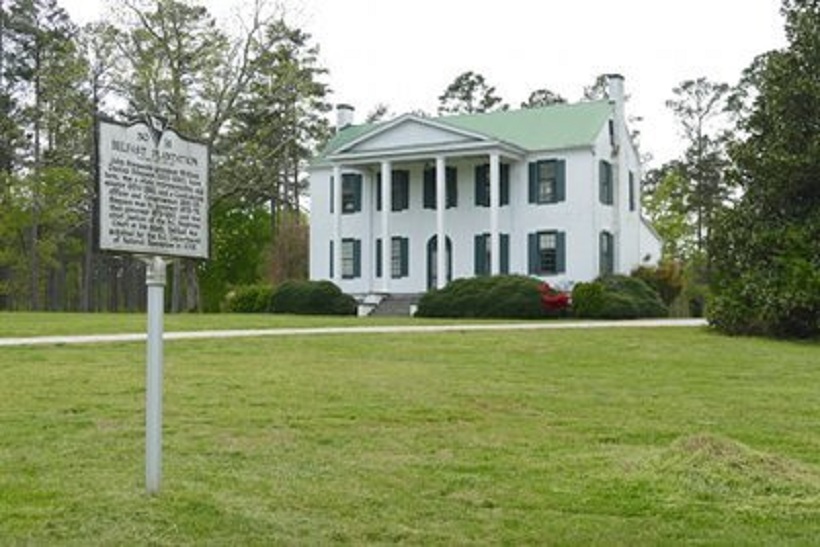
A plantation house built in Laurens while our Howells were in the area
I've found no evidence that our Howells were slaveholders themselves
While John Wesley Howell is geographically logical as part of our line, if I
didn't have DNA evidence I still wouldn't feel comfortable proceeding with it.
Recall that our Howells in the Mississippi Delta were poor and illiterate.
Well, John Wesley Howell was a surgeon. He served in that role in the Marines
beginning in 1801, and he died in 1808. While Laurens was a cotton hotbed like
the Delta with a majority slave population, the situation of our Howells in the
former seems completely different from the latter. John was not a slaveholder.
It seems clear that as our Howells went west, their prospects and social status
plummeted. It might've been different if not for the disaster that was
Reconstruction after the Civil War. Of course one could attribute that disaster
to a slave economy having been implemented in the first place.
John's father was William, and he lived his life in Virginia. I know of two
William Howells in Virginia at that time, and ours was the one born around 1725
and died 1779 in Frederick County. Frederick was the northernmost Virginia
county at that time, bordered by what would become West Virginia to one side and
the future District of Columbia to the east. So, it was quite a move when John
ended the line's time in Virginia and went all the way to the South Carolina/Georgia
border at Laurens. Laurens County was formed from the Ninety-Six District in 1785,
and John probably went there about the same time, having turned 20 in 1777. Elbert
County Georgia was also first settled then, where our line would later move to.
John's migration began a span of about 70 years for our Howells residing in South
Carolina and Georgia.
ThruLines supports William as John's father. I found two cousins who independently
connect to William, through his children Jilson and Catherine. William's father is
too distant from my father for ThruLines to identify relation to him. William
being the endpoint makes it more likely that he could be wrongly named, but the two
independent connections from ours are enough to work backward from. As mentioned
above, John turned 20 at the time of the Revolution. I expect he served as a
soldier, though I've found no documentation of it. But William definitely did,
even though he was about 50 years old at the time. He was a wagon master in the
11th Virginia regiment. As also previously addressed, he died in 1779 during the
War, of smallpox.
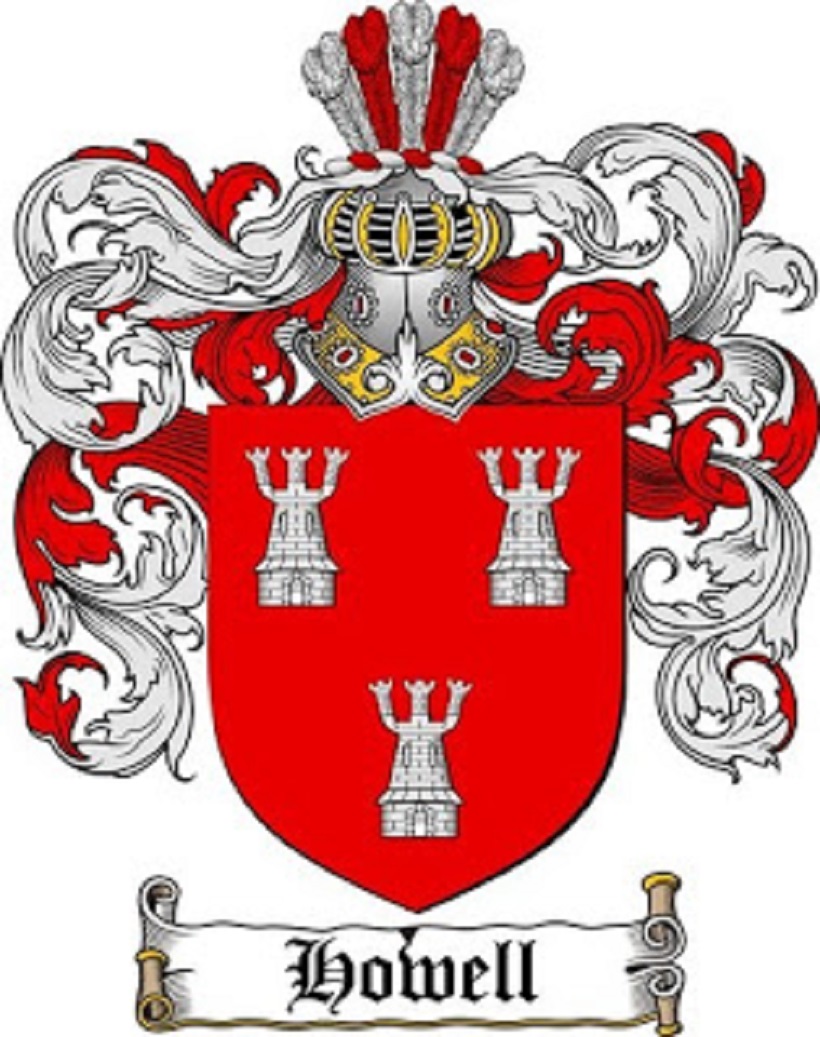
The precise line of descent of our Howells going backward in Virginia becomes
unclear, but William is believed to have been the son of a William who died in
Frederick County in 1747. He probably had recently moved there, because Frederick
was formed in 1743. All I've learned about Frederick to note is that George
Washington had his headquarters there during the French and Indian War two decades
before the Revolution. William Jr might've served him there, being 20 years old
then, but I've found no record of it.
Our Howells are believed to have moved to Frederick from Augusta in Hampshire
County. William Sr was probably born about 1695, somewhere in Virginia. Two
immigrant Howells to Virginia were Etheldred who was in Jamestown once it had
become solidly established, and John who was in Henrico County in the 1630s and
was wealthy. John seems the more likely of the two to be our patriarch, with
William Sr being the son of John's son's John's son Thomas. In other words,
William Sr may have been the great-grandson of patriarch John. The latter was
born around 1585 in Wales. There may also have been another John Howell of the
same area of Wales who was born in 1598 and came to Isle of Wight Virginia. A
John Howell lived in Charles City County on the south side of the mouth of the
Appomattox River in 1669. So, as I said, it isn't certain that we descend from
one particular John, but all leads point to one part of Wales as the line's
origin. And when John Wesley Howell left Virginia, our line had been there for
as much as 150 years.
ThruLines supports John Wesley Howell having a brother named Ralph Raeford
Howell. Ralph's line has been better-researched than ours, and they claim that
the line of descent to Ralph was William, Thomas, John, John, John, Edward,
Henry, and William, where the eldest John was the immigrant. Ralph's descendants
have also been tested for Y-DNA, which is the same as ours. I will come back to
that.
Howells in Wales
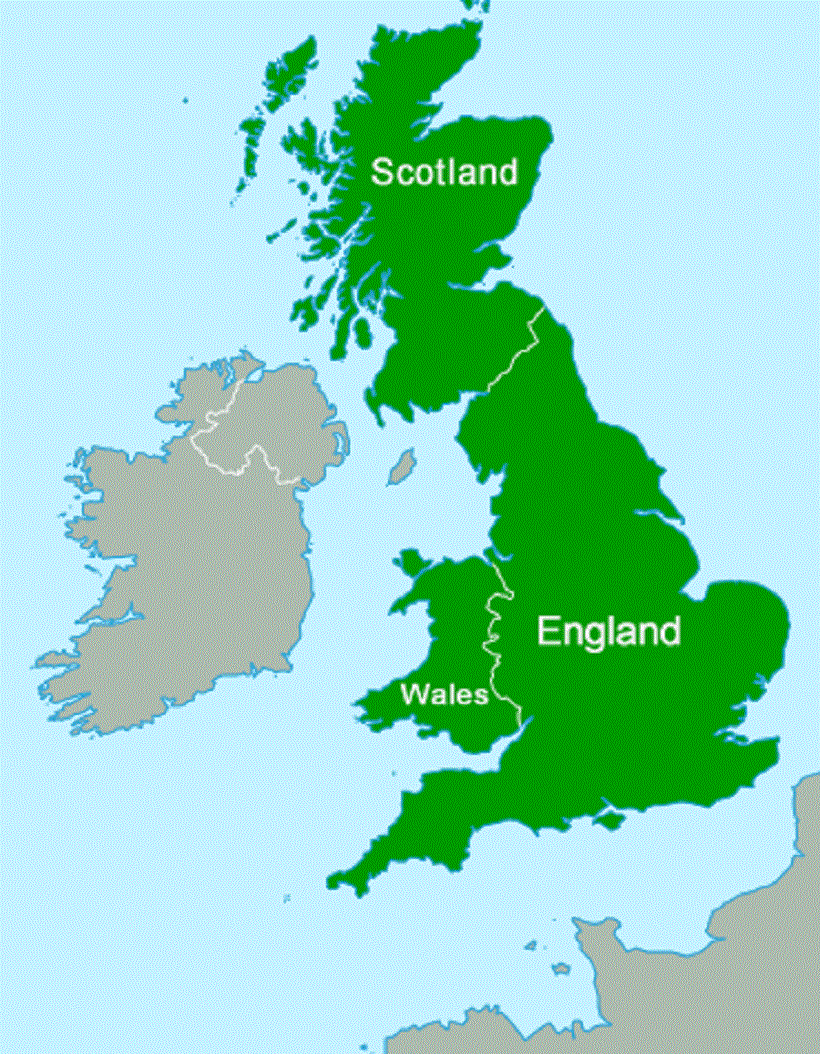
The ultimate origin of the Howell surname is Wales. Researchers of Ralph Howell
have the line first going from Pembroke to Buckinghamshire England, and then to
Virginia. Our line seems very much to have been drawn toward English culture by
the time they immigrated, with English names and living for a time there before
coming to America. And the Y-DNA is curious for Wales. But let's go backward in
time before tackling these questions.
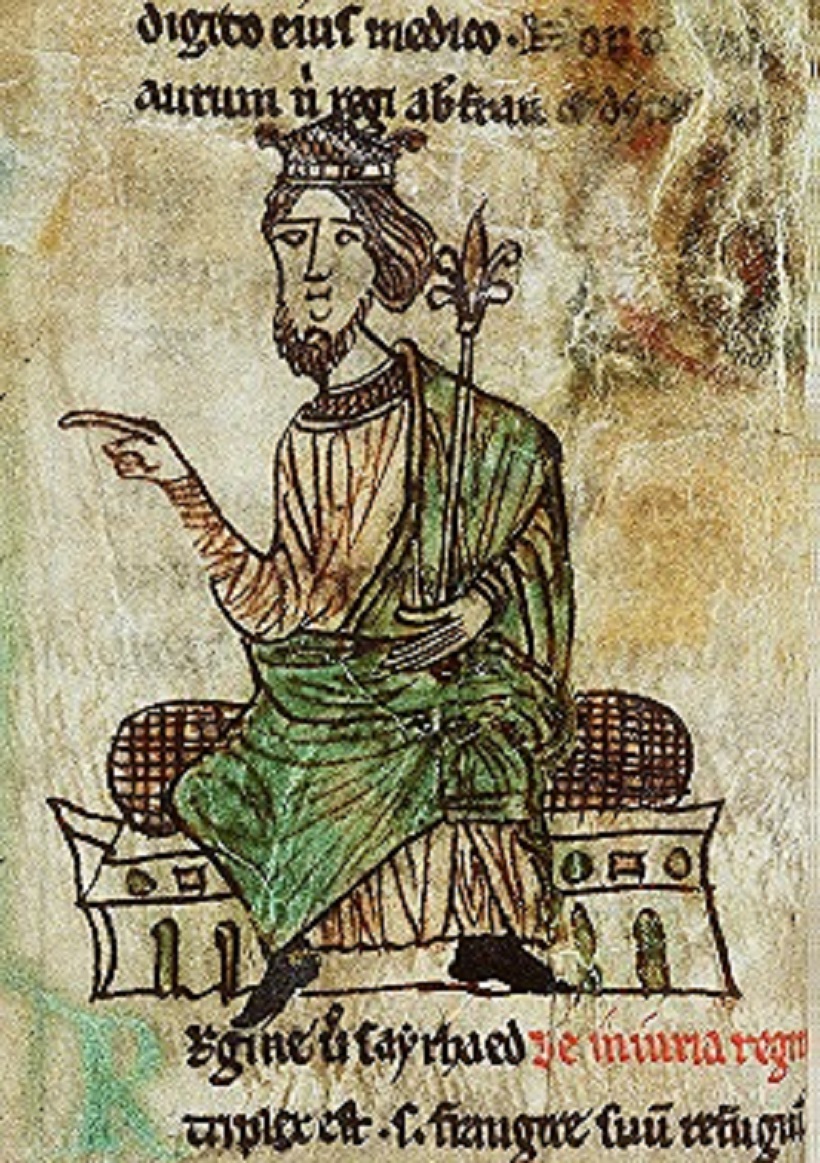
Hywel Dda, or Howell the Good
The surname Howell originates from a king in Wales called Hywel. Y's in Welsh are
used like short u's, so the pronunciation was similar. He was born about 900AD
and is remembered for his code of laws which were considered "good". He ruled a
kingdom called Deheubarth, in the southwestern part of modern Wales. The
potential patriarch John that I mentioned before claimed descent directly from
Hywel. I'll return to that subject, but for now note that the Howells who went to
Virginia came from Pembroke in Wales. See the illustration below of Pembroke in
1610, and its geographic location. Pembroke actually was founded by Normans 200
years after Hywel's time, with the name meaning "Land's End". Hywel came from
adjacent lands to the east, and all of that area was part of his kingdom.
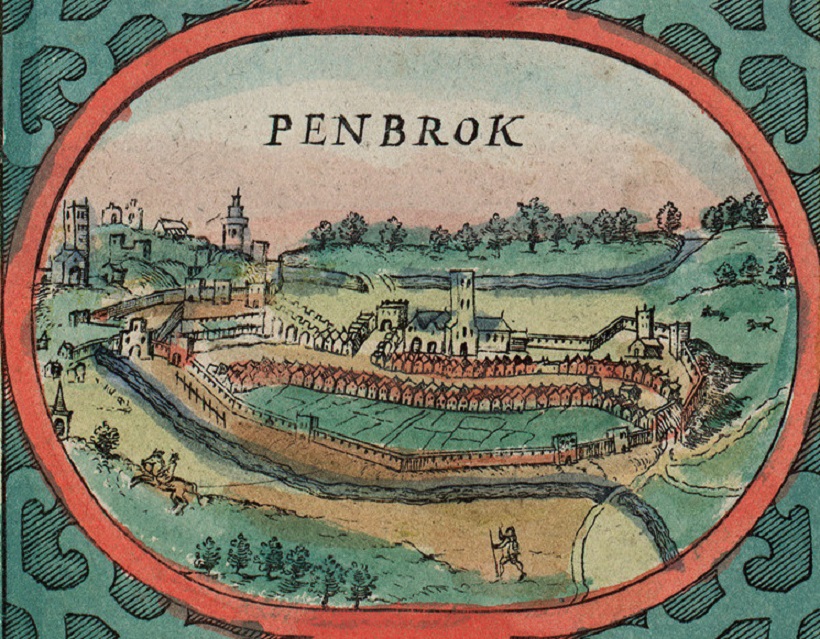
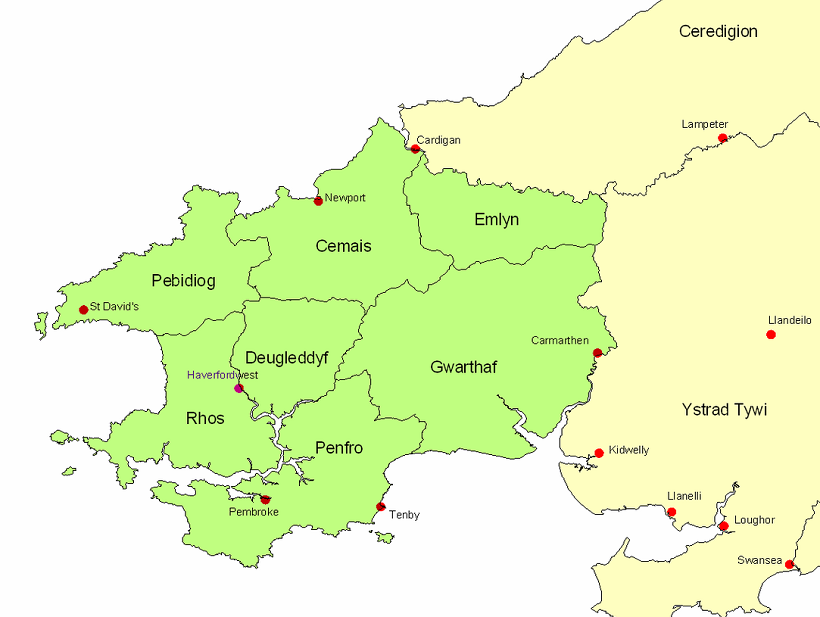
Wales was politically merged with England in 1535 and the two have moved closer to
being a single entity since then, with Wales retaining more of the Celtic
character that preceded the Romans in all of Britain. As I stated, our line
certainly merged into English. I have doubts that ours had roots in Pembroke
before its founding, but note that the area was
historically the kingdom of Dyfed from the time of the Romans to the rule of Hywel.
Dyfed was named after the Demetae people. The Demetae didn't contest Roman power,
but they also didn't become Romanized. The Demetae were closely related to the
Brittonic tribes where Hadrian's Wall was built, and Wales's interest in that
region is why they referred to it as the Old North. Wales and the Old North became
culturally isolated about 616AD by the development of England as a country.
In previous analyses, I noted that Ralph Raeford Howell's Y-DNA was known, and I
wasn't sure about our line, and I doubted that Ralph was an ancestor. But I've
since learned that he was Jon Wesley Howell's brother, and therefore we have the
same Y-DNA as him. I had assumed that our Howells were R-M269, the vastly most-common
haplogroup in Wales, but Ralph's descendants have been tested as I-M253.
So, our line was actually a very rare strain in Wales. I'm certain that Hywel Dda
was R-M269. Therfore I'm sure that claims of our line tracing back to him are false.
I'm not as knowledgeable about Welsh history as English or Scottish, for example,
but I'm guessing that our line adopted the Howell surname, in the 15th or 16th
century. The line was well-off when it immigrated to Virginia, so I guess they
might've actually believed they were descended from Welsh royalty.
Deeper History
Our Howells might well have come from Welsh royalty, but of a different origin
than Hywel Dda. Look at the map below of the
concentration of haplogroup I-M253. Our line came from Vikings. They were Welsh,
but not from the predominant Celtic tribes. They became Welsh. I have a considerable amount of
Scandinavian DNA, yet not a one of my 6th-great grandparent surnames are
categorized as Scandinavian. This means my Scandinavian forebears were Vikings
who settled throughout the British isles long before surnames were adopted. In
the case of our Howell line, they come from Vikings who settled in Normandy.
They came with William the Conqueror to England, and they were part of the
founding of Pembroke in Wales.
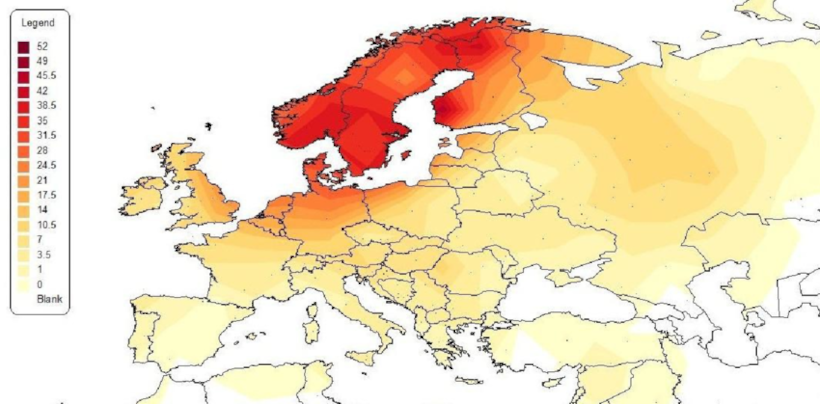
Y-DNA Haplogroup I-M253
Vikings began to raid the peninsula that would become Normandy in the 7th century.
It became such a problem for France that they decided to cede the territory to
them. The name Normandy comes from North-men, or Vikings. As was the case in
other places they settled, the Normans became intensely French. Our line was
part of this, and they came to Normandy from Denmark or the nearby part of Norway.
Considering the even deeper origin of our Howells, the I-haplogroup had a very
similar origin to the J-haplogroup of our Scott line. But while the Js made
their mark in the Middle-East, the Is flourished farther to the west. I-M253 is
also known as I1, which split from I2. I2 is most common in the Balkans. I1,
as shown above, set its roots all the way up in Scandinavia. I haven't researched
the I-haplogroup much, but an obvious question is why its flourishing was so
far-offset from its origin. The R-haplogroup was similar, so it was probably for
the same reason. Maybe something to do with the last Ice Age delaying their
development.
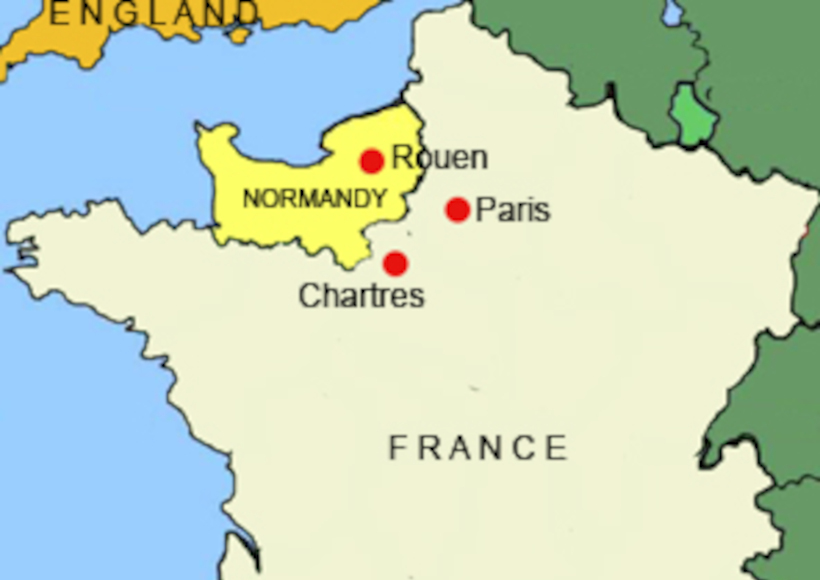
Sam Howell's other Great-Great-Grandparent Lines
In the last phase of this document, I collect all that I know about the non-Howell paternal lines of the great-great-grandparents of my great-great-grandfather, Sam Howell. Refer to the Scott Pedigree page for a simple view of Sam's ancestors.
Ellis
For a long time, I only knew that Sam Howell's mother was named Nancy T. It left
half of the family lines in Sam's tree unknown. As described previously in this
document, by census search I determined that Nancy's parents were James Ellis and
Ellen. I had a lead that Ellen's maiden name was Anderson, but with no parents
identified. ThruLines showed no matches for either of them, I believe because I
was the only one on ancestry.com to have them in my tree. By more census
searching, I found a Guy Ellis in Panola County of similar age to James, and put
Guy and his father John Ellis in my tree to see what ThruLines would say. I've
subsequently applied this methodology throughout my family tree, of making an
educated guess at the parents of a person and seeing if ThruLines found any
connections.
In the case of Ellis, ThruLines returned only one match, and it identified James
as the half-brother of Guy. At the time I had my doubts about ThruLines,
thinking that it could be easily confused by wrong information in members' trees,
and I was unsure about the single match. But it did say that I was related to
another person who'd been tested, through Guy Ellis, making John Ellis my
ancestor. Since then I've gained a lot of confidence in ThruLines, and even with
only a single connection through Guy, still only two for James, and four for John
Ellis, I have complete confidence that it's accurate. This is made ironclad by
the entire tree of Nancy Ellis, ancestors of John Ellis, and Ellen Anderson which
I will get to in that section of this document, being validated by ThruLines.
The reason why there are so few matches is either that few descendants have been
tested, or they had few descendants, or very few who have been tested have
figured out their family trees.
I suspected, as soon as my ethnicity report was coming back as 1% Nigerian, that
the Ellis line was where it came from. I told previously of how I looked at
cousin autosomal DNA for ones who also had Nigerian, and in that way narrowed
the likelihood to Sam Howell's mother Nancy. As soon as I found the Guy Ellis
connection, and saw that John Ellis didn't even list James in his will, that
Guy's mother was John's legal wife and James's mother was a slave of John Ellis.
I still believe that today, and I believe I have a name for her. I'll save that
for the Nigerian section below.
But back to the Ellis men, James was born in 1810. He claimed it was in North
Carolina, but having researched the Ellis history, they were in Church Hill,
Hawkins County Tennessee in 1810, so therefore I believe James was born there.
Hawkins is in the Holston area. John was born in 1772. It's possible that
James was passable as white, or Black
Dutch, as he was a free man in Mississippi before the Civil War. But I have no
documented categorization for him or his daughter Nancy. The last thing I have
to say about James is his father didn't have children attributed to him until he
was 34 years old, so he might've fathered James actually before 1803 when he was
married. John's legal wife was Nancy Hale, Guy's mother.
I've had John's birthplace as North Carolina, but it actually seems that the
Ellises came directly to Tennessee from Virginia. John was most likely born in
Botetourt County, and if James was born before 1803, it was probably there.
John put his birth year in his bible, but didn't say where he was born. He
died before birth places were documented in the census.
And now, even with the already iffiness of this line, we come to another issue.
Ancestry.com suggests a John Ellis Sr as John 1772's father. But ThruLines
returns zero matches. We do get matches for John Sr's wife Mary Rhodes. She
is an ancestor. In the process of researching John Ellis, I came across another
drama that Ellis descendants encountered when testing their Y-DNA. They found
that sons of John Sr didn't all have the same Y-DNA, and they determined that
John 1772's descendants actually matched a John Neely who made a similar move
from Virginia to Hawkins County Tennessee. But when I put John Neely as John
Ellis's father, I still get zero matches. I trust the work that was done with
the Y-DNA, and can only guess that no one else on ancestry.com has put John
Neely as John Ellis's father. Either that, or some other man was the father
of John 1772. I can't use ThruLines to clear it up, as John Neely's parents
are my father's 6th great-grandparents and out of range to make connections to.
Working under the assumption that John Neely was my ancestor, I don't know
where in Virginia he was born in 1748, but presumably it was Augusta County,
from which Botetourt was formed in 1772. John's father was James Neely, who
was born in Ireland. Neely is a Catholic Irish surname. This is a line with
a known non-patertal event, and I'm not sure how to handle it. Culturally,
the Ellises were English and probably Anglican upon immigration. They were
obviously slaveholders. It looks like the Neely Y-DNA was R-M269, while the
Ellises were the Viking I-M253. I think it makes sense to consider the
religion and country of origin culturally, as English Anglican, and the
genetics from Neely. I've seen reference to a town called Neely in Ulster,
though it's not on the map now. I see the name in businesses around Belfast.
Brown
While I recently knew nothing about the Ellis side of Sam Howell's ancestors,
I also new nothing about the ancestors of Sally Brown, KD Howell's mother.
The majority of Sam Howell's ancestors were unknown. And after much work I
made little progress in filling out his tree. But I recently made a
breakthrough in the use of ThruLines that has broken down brick walls all
over my family tree, not just Sam Howell's part. In the case of the Brown
line, little was known about KD's parents. The only document I had for
Sally was her wedding of Samuel, KD's father.
The way I pursued an educated guess for Sally's father was to manually search
the 1830 Elbert County Georgia census. Sally wed Samuel there in 1821. I
found many Browns in it. It turned out that her father had moved on to
Habersham County, but I still was able to find him. I found that the closest
Brown to Samuel and Sally was William Brown, who was in his 60s. I targeted
him as the potential father, and the next step is to use resources like
wikitree.com or geni.com to find William Brown born in the 1760s who lived in
Georgia. I found him, but then I realized he couldn't have been Sally's
father, because he had a daughter named Sarah who died young.
The next step is to look at William's father and all his sons. It was then
I learned that William's father was none other than Abraham Brown of
George C McAtee's tree. Digging deeper, it was clear that multiple children
of Abraham Brown ended up in Georgia. Looking at all of Abraham's sons, I
found that Robert was the best potential father of Sally, even though no
Sally or Sarah was listed as his child. Robert's children were born in
South Carolina, as Sally was suspected of having been, and he and sons went
on to Elbert Georgia and neighboring counties. I didn't have a name for
Robert's wife, so I didn't put one in at first. But ThruLines reported 20
matches through Robert's other children, confirming him as Sally's father.
And connections are reported independently for both my parents to Abraham.
See the McAtee document for more on this line, where my determination
was they were Scottish, yet Anglican slaveholders. The Y-DNA haplogroup is
J-M67, the same Middle-Eastern group as the Scotts. See the Scott document
for my analysis of how so many Scottish lines had a Middle-Eastern Y-chromosome.
Anderson
As mentioned previously, I had a lead that James Ellis's wife Ellen's maiden
name was Anderson. I believe it came from someone who made a family tree
for everyone that was in the 1860 Panola County Mississippi census. I had
no lead on who Ellen's parents exactly were though, and ancestry.com returned
no hints to help. So I had to resort to making an educated guess and rely on
ThruLines to support it. I made the guess by manually searching the 1850
Panola census. In it I found several Andersons and I targeted a George born
1801 in Tennessee as a prospective father. The ThruLines response was tepid,
with only one match, and I had no lead on George's wife. I felt that George
should be correct, as he was in Hawkins County Tennessee, and I knew the
Ellises had been in Hawkins.
The general state of research on the Andersons was a confused mess. But I
was able to place a name for George's wife, and opening that part of the
tree led to a fairly notorious group and lots of cousin connections. So,
being certain of Ellen's mother, I then gained confidence in the father and
proceeded. George Anderson was born about 1780 in Grayson County Virginia.
This is in the southwestern tip, near the Holston area and also near North
Carolina. George died 1834 in Hawkins County Tennessee. George's father
was John Anderson, born about 1760 in Hanover County Tennessee. ThruLines
returns three times as many matches for John as George, so this is definitely
our line. John's father was Robert Anderson, born 1712 in New Kent County
Virginia. This begins a series of Roberts in this line: Robert born 1673 in
New Kent, and Robert born 1641 in York County Virginia. Richard Anderson was
the immigrant, born 1618 in Hertfordshire England.
The Andersons were slaveholders, living on a plantation called Goldmine in
Hanover County. Presumably they were Anglican. I've not been able to access
the Anderson DNA project, but I have seen a line that was distinguishing
themselves from ours by narrowing down to a specifically Pictish branch from
R-M269. Therefore my guess is ours was another branch from R-M269. It
seems that the line immigrated to the Goldmine creek from the beginning, as
it was in York County in 1635, then New Kent when it was formed, then
Hanover when it was formed.
Wilson
John Wesley Howell's wife was Polly Wilson, born 1760 in South Carolina. Polly's father was William Wilson, born 1740 in Kingstree, Williamsburg County South Carolina. This is to the north of Charleston and west of Myrtle Beach. Polly's claimed birthplace was Laurens County, but it was founded decades after 1760. I think she probably was born in Williamsburg like her father. William's father was Robert Witherspoon Wilson, born 1710 in Brae, Angus, Scotland. Robert landed in Charles Town in 1732. Wikitree.com traces this line a few generations back in Scotland. It's said that all of the early immigrants to Williamsburg County were Presbyterian, and Robert is documented as being a member of a church there. He's also claimed to have been a Revolutionary War soldier, though he was 66 years old in 1776. This line is documented as not being slaveholders. If there's a relation between this line and the one in the Scott tree, it was in Scotland. I was unable to find a connection for this line in the Wilson DNA project. Houseofnames.com claims that Wilson is Viking in origin, which makes sense. But as I stated for the Howells, Vikings came to Britain centuries before surnames were adopted. In the Wilson DNA project, there are five times more R-M269 than I-M253 haplogroup. Therefore I have to guess that ours was R-M269.
Chambliss
As has been typical in Sam Howell's tree, when I identified Robert Brown as
an ancestor, I had no maiden name for his wife. I saw claims that her name
was Catey. I found guesses made by other researchers that Robert Brown's
wife was a Tollett or a Borden. I attempted to find a Borden who could've
had a daughter named Catey in the right place and time, but I found none. I
tried Markus Tollett as Catey's father, and I initially thought I'd found
the connection, but after more days passed, the matches to him decreased to
zero. The lesson learned from this is that ThruLines requests a day to pass
before it updates matches, but it takes longer than that for it to work it
all out. It can give a false positive in the couple of days after a person
is entered in the tree. So I went back to searching, and I found a Tribble
wed to another Brown woman, but I found no other Tribble who could've been
Catey's father. I found a Brown who wed a Martin woman, but I couldn't find
a Martin man who could've been Catey's father. All of these guesses were
informed by the 1790 Abbeville South Carolina census. I identified James
Lowery and Anna Irvine as potential parents, but ThruLines didn't support them.
Part of how Catey was known as the correct first name, is she was known to
have wed a Stubblefield man after Robert Brown died. When Catey died as a
Stubblefield, her executor was Timothy Chambliss. I wondered if he might've
been her nephew, and her maiden name was Chambliss. I then found a
Christopher Chambliss who died in South Carolina and was of age to be her
father. So I put Christopher and his wife Mary Crawford in as Catey's parents,
and ThruLines found 8 matches for each and this remained consistent. Thus I
found that Robert Brown's wife and Sally Brown's mother, was Catey Chambliss.
Christopher was born about 1730 in Prince George County Virginia. I know
nothing else about this line, but Chambliss is a French surname from Burgundy.
There is a Chambliss DNA project, but I found no connection to Christopher.
Still, they are all R-M269. I have to assume the line was Lutheran upon
immigration. Christopher lived too early to leave records of slave owning.
Nigerian
I'm very certain that the 1% Nigerian in my autosomal DNA ethnicity estimate
came from Nancy Ellis, Sam Howell's mother. I know who her parents were.
I'm very certain that Nancy's Nigerian ancestry came from her father. Her
mother's side was racially diverse, but none from Africa that I'm aware of,
and certainly not at a level that I would inherit in a measurable amount.
I know who James Ellis's father was. That leaves his mother as the pathway
of Nigerian ancestry to me. James was born from 1800 to 1810, long before
the Civil War. I don't think he ever was enslaved, and he certainly was a
free man when he raised his own family. My assumption is that he was able to
pass as white, to be a free man in Mississippi before the Civil War.
But I'm certain that his mother was a slave. I'm certain that James's father
owned her as property. I suppose that anyone with such a situation for
ancestors would like to believe it was an affectionate relationship. But
when one of them isn't free to chose, regardless, it's a crime. I won't use
the word for it out of respect. But you should be able to figure it out.
I know from watching Finding Your Roots that it's rare for an African American
to know much about enslaved ancestors. I may never know anything about James
Ellis's mother, other than her carrying enough Nigerian DNA to pass it down
all the way to me. But as is the case throughout my family tree, I have some
theories that are shaped by what evidence I can find.
John Ellis, James's father, owned nine slaves in 1830. When he died in 1844,
he left a will. He named his children one after another, but he didn't
mention James at all. He doled out his possessions, going through furniture
and cattle. Named after his furniture, after his cattle, were his slaves.
He left slaves named George, Frances, and Mary to his daughter Joanna. He
mentioned a slave named Sarah. He gave a mulatto slave Harriet to his
daughter Betsey. He declared that the rest be sold. The 1830 census didn't
list slaves by name, but it did note ages. Six of the nine were female - all
were young except for one, who was 36 to 55 years old. I believe that woman
was James's mother. I also believe that she was Harriet, described as
mulatto in John's will. I certainly can't prove it, but I doubt very much
that James could've been a free man in Mississippi before the Civil War if he
was half Nigerian. I would guess that one of his grandparents was a slave,
but he might've been even less than one quarter African.
I named this section Nigerian, but I believe that Harriet's father was a
white man. He wasn't the John Ellis Sr who was the putative grandfather of
James, because I've tried putting him in the tree and ThruLines returns no
matches. I don't think John Neely was the father either, or he certainly
would return matches being my ancestor twice over. There's likely no way
to know what the paternal line is here. This section is applicable also to
Harriet's mother, whatever her name was, whether or not she was property of
the Ellises. If Harriet's father actually was a slave, he wasn't allowed
the dignity of a surname. But my assumption is that none of Sam Howell's
great-great-grandparent paternal lines were Nigerian. I believe that two
people in this tree were slaves - Harriet and her mother. For the sake of
having sixteen lines, I'm going to assume that Harriet's and her mother's
paternal lines were the same as the Ellises.
Sizemore
Ellen Anderson's mother was Rhoda Sizemore. Rhoda was born 1780 in what
would become Ashe County North Carolina. In 1780 there was no state of
Tennessee, and that territory was Washington County of North Carolina.
Technically what would become Ashe County was in Washington County in
1780. At some point before Rhoda was married, her family had moved to
Hawkins County Tennessee. Rhoda's father was Owen Sizemore, born 1755 in
Rowan County North Carolina. Owen's father was Edward "Old Ned" Sizemore,
born 1725 in Brunswick County Virginia, in a part that would become
Lunenburg County in 1746. Ned's father was Henry Sizemore, born 1698 in
Henrico County Virginia. Henry's father was Ephraim Sizemore, born 1669
in London England. The Sizemore name is said to come from Scarisbrick,
Lancashire England. Houseofnames.com claims that size-more is an
anglicization of this Norwegian original settlement name, but that doesn't
make a lick of sense to me.
This tells the tale of an apparently typical English line. But the
Sizemores were notorious for at least two reasons. One, Old Ned died in
1780. You might guess that he died in the Revolutionary War. He did.
But he wasn't killed in service of the Patriots. He was hung in
Wilkesboro North Carolina for being a Tory, which was the name for a
Royalist, someone who fought against independence. Owen was also a Tory,
and he and his brother deserted from a South Carolina militia in Camden
in 1781. I haven't found any explanation for how Owen remained in
America. Maybe he had to serve time or paid some other punishment.
Maybe he just hid out. Maybe 1781 was late enough that he could get by.
He ended up in Hawkins County Tennessee.
The second notorious element of the Sizemores, is they were a Melungeon
family. Melungeon is a term for mixed race like Black Dutch, for people
who couldn't necessarily pass for white, lived apart from neighboring
communities, and weren't enslaved. I'm not sure what part African
ancestry played in Melungeons, but for the Sizemores they seem to have
only mixed with Native Americans. I haven't identified any Native
connections within Sam Howell's great-great-grandparents, but I expect
there were several in earlier generations. It makes sense that Ellen
Anderson wed James Ellis, as she was also of mixed race. Obviously she
wasn't as much Native American as James was Nigerian, or hers would show
up in my DNA too, and surely my dad's.
That said, there are many male Sizemore descendants who test as Y-DNA
haplogroup Q-M242, which is Native American. Some researchers have used
this to believe that all Sizemores, including the ones in Hawkins County
Tennessee, were Q-M242. There may have been some in Hawkins, but it
seems that they congregated in Clay County Kentucky, not far away. One
piece of evidence that our line went back to England as I described, is
the lack of Native American DNA in my dad. Another is that I found no
connection to Owen Sizemore in the Q haplogroup in the Sizemore DNA
project. It appears that a Native boy was adopted into the Sizemores in
Virginia, maybe South Carolina, probably when they were significantly
mixed already. Research targets Henry as this boy's name, but not the
same person as our Henry born 1698. I've seen claims that the Native
Henry was the half-brother of an Ephraim Sizemore, but this couldn't
have been our Ephraim born in England. It must've been a later Ephraim
named after him. As with most 17th century lines, research out there is
very confused. If I were to use trees on wikitree and geni as a guide,
I would think our line was Q-M242. But the Sizemore DNA project, which
actually uses DNA, makes no such connection and suggests that our line
was R-M269.
In researching the Sizemores, I saw a claim that the name Rhoda occurred
often among them, and that it came from the surname Rhodes. So, surely
our Rhoda Sizemore descended from a Rhodes, although outside Sam Howell's
great-great-grandparents. Sam did have a Rhodes great-great-grandparent
though, on the Ellis side. So, James and Ellen were cousins. This was
multiple generations apart, but they probably knew. Our Sizemore line
was English and likely originally Anglican. Though they lived in
plantation areas, it seems that they were not slaveholders.
Lewis
John Wesley Howell's mother was Leticia Lewis, born 1727 in Spotsylvania County Virginia, in the part that became Frederick County in 1743. Leticia's father was William Lewis, born 1684 in Fairfield, Northumberland County Virginia. William's father was John Lewis, born 1657 in Northumberland. John's father was also named John Lewis, born 1611 in Oswestry, Shropshire England. John's father was also named John Lewis, born 1585 in Llanisien, Glamorgan Wales. A book was written about John III, and it appears that the family owned a lot of land in the Northern Neck. I know of no direct proof that they were slaveholders, but I assume they were. They definitely were in the tobacco business. Presumably this line was Anglican. Like the Howells, descendants of this line have been tested as Y-DNA haplogroup I-M253. Our Lewis line thus also came from Normans whom in this case were part of the establishment of the Lordship of Glamorgan around 1100 AD.
Armstrong
Sam Howell the elder's maternal grandmother was Elizabeth Armstrong. ThruLines strongly supports her, but she was my dad's 5th great-grandparent, so it can't prove her parents. I believe that Elizabeth's father was James Armstrong born 1690 in County Fermanagh Ireland, but nothing is clear. Armstrong is from the Scotland/England border and can come from either side. Given that ours went through Ireland, I'd have to assume they were Scottish. But they followed an Anglican path in America. I have no evidence that this line were slaveholders. The best guess for Y-DNA haplogroup is R-M269.
Kirkham
Robert Brown's mother was Margaret Kirkham. This is how she was my father's ancestor. Refer to the McAtee document for an analysis of this line, as she was also my mother's ancestor.
Crawford
Sally Brown's maternal grandmother was Mary Crawford. Her name was written as Crafford in documents. Crawford/Crafford means ford of crows in Old English. It could be Scottish or English, probably from the border region. This line seems to have been Anglican. I don't know who Mary's father was.
Rhodes
John Ellis's mother was Mary Rhodes. She came to Hawkins County Tennessee from Goochland County Virginia. Though it's expected that we have Rhodes ancestors on the Anderson side of the tree as well, I don't know who Mary's father was. Rhodes is an English surname from Yorkshire.
Robison
George Anderson's mother was Mary Robison. Mary had to be in Grayson County Virginia, and likely was in Hanover County. I know nothing else about her. Robison means son of Robert, while Robinson means son of Robin. I presume this is a Scottish line that was probably Anglican. It was probably also Viking in origin, genetically.
Bingham
Rhoda Sizemore's mother was Arty Bingham. Arty came to Ashe County North Carolina, but she was probably born in Virginia. Thomas Bingham was related to her, and may have been her father. His line came to the south from Connecticut. That might seem implausible, but there were men who were ordained as Baptist preachers in the north and went to the south where there was demand for their services. A Thomas was the patriarch of the line, born 1642 in Sheffield England. This line has been tested as Y-DNA haplogroup R-M269.
Summary of Sam Howell's Great-Great-Grandparent Lines
Six of the sixteen lines were known to be slaveholders. Note that
pre-1800 documentation is limited and more of these lines likely owned
slaves. At least two of Sam's ancestors were slaves themselves, but
though he did have male Nigerian ancestors, I don't think any of his
great-great-grandparent lines were Nigerian. Half of his ancestry was
English, and most of the rest was Scottish. There were two total
Welsh lines, including Howell, and interestingly both were of Viking
origin. All but two of the sixteen lines were Anglican. Three
quarters were the standard R-M269 western European Y-DNA haplogroup,
while three were Scandinavian and one Middle-Eastern like the Scotts.
Migration paths
Howell: 1855 Peach Creek, Panola, Mississippi - 1820 Christian, Elbert, Georgia - 1780 Laurens, Laurens, South Carolina -
1720 Winchester, Frederick, Virginia - 1670 Smithfield, Isle of Wight, Virginia - 1620 Marsh Gibbon, Buckinghamshire, England -
1100 Pembroke, Pembrokeshire, Wales - 700 Rouen, Normandy, France - 0 Aalborg, Denmark
Ellis: 1841 Batesville, Panola, Mississippi - 1803 Church Hill, Hawkins, Tennessee - 1748 Buchanan, Augusta, Virginia -
0 Neely, Ulster, Ireland
Brown: 1820 Elberton, Elbert, Georgia - 1780 Abbeville, Abbeville, South Carolina - 1755 Lexington, Rockbridge, Virginia -
1725 Newtown, Bucks, Pennsylvania - 0 Edinburgh, Midlothian, Scotland
Anderson: 1800 Mount Carmel, Hawkins, Tennessee - 1780 Volney, Grayson, Virginia - 1635 Rockbridge, York, Virginia -
0 Tring, Hertfordshire, England
Wilson: 1780 Laurens, Laurens, South Carolina - 1732 Kingstree, Williamsburg, South Carolina - 0 Brae, Angus, Scotland
Chambliss: 1790 Abbeville, Abbeville, South Carolina - 1730 Prince George, Prince George, Virginia - 0 Chablis, Burgundy, France
Sizemore: 1781 Church Hill, Hawkins, Tennessee - 1775 Jefferson, Ashe, North Carolina - 1750 Salisbury, Rowan, North Carolina -
1720 Victoria, Brunswick, Virginia - 1695 Richmond, Henrico, Virginia - 1660 London, London, England - 0 Scarisbrick, Lancashire, England
Lewis: 1710 Winchester, Spotsylvania, Virginia - 1650 Fairfield, Northumberland, Virginia - 1610 Oswestry, Shropshire, England -
1100 Llanisien, Glamorgan, Wales - 700 Rouen, Normandy, France - 0 Allborg, Denmark
Armstrong: 1730 Staunton, Augusta, Virginia - 1650 Enniskillen, Fermanagh, Ireland - 0 Cargenbridge, Dumfries, Scotland
Kirkham: 1740 Staunton, Augusta, Virginia - 1690 Kent Island, Queen Anne, Maryland - 1680 Easton, Talbot, Maryland - 0 Kirkham, Lancashire, England
Crawford: 1730 Surry, Surry, Virginia - 0 Crawford, Manchester, England
Rhodes: 1750 Goochland, Goochland, Virginia - 0 York, Yorkshire, England
Robison: 1780 Volney, Grayson, Virginia - 0 York, Yorkshire, England
Bingham: 1760 Asheboro, Randolph, North Carolina - 1665 Norwichton, New London, Connecticut - 0 Sheffield, South Yorkshire, England
last edited 1 Nov 2022
